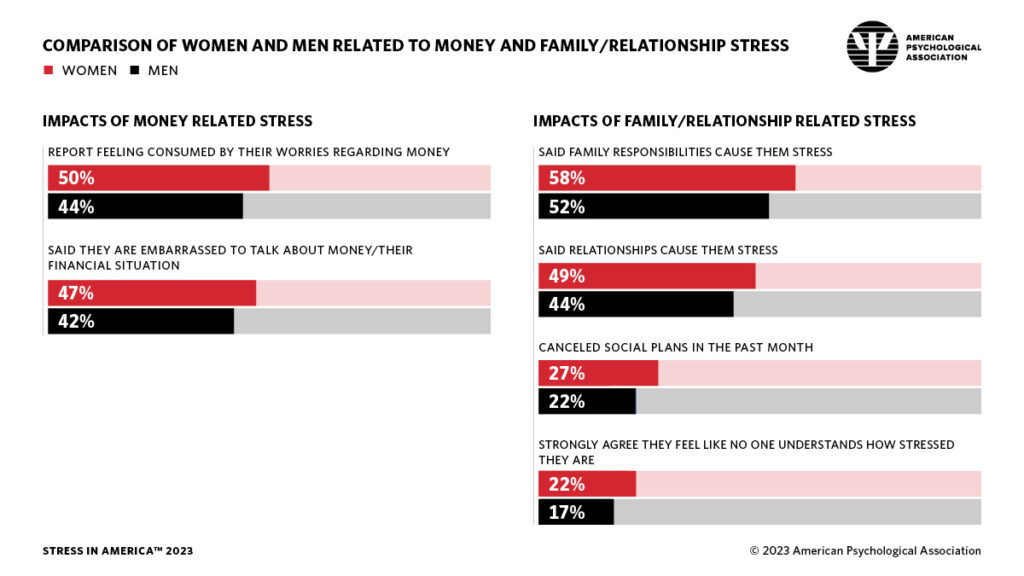
The APA has been quantifying Stress in America since 2007; for context, at the end of that year The Great Recession kicked in, and in response President Obama’s team put together assistance to bolster the national economy, jobs, and health technology (codified in the American Recovery and Reinvestment Act).
American health citizens are experiencing a deja vu in 2023 akin to their financial stress experienced in the APA 2008 Stress in America survey: money stress is a key factor in peoples’ overall mental health in 2023.
As in 2008, in 2023 even more women than men feel that financial stress — and more generally, parents.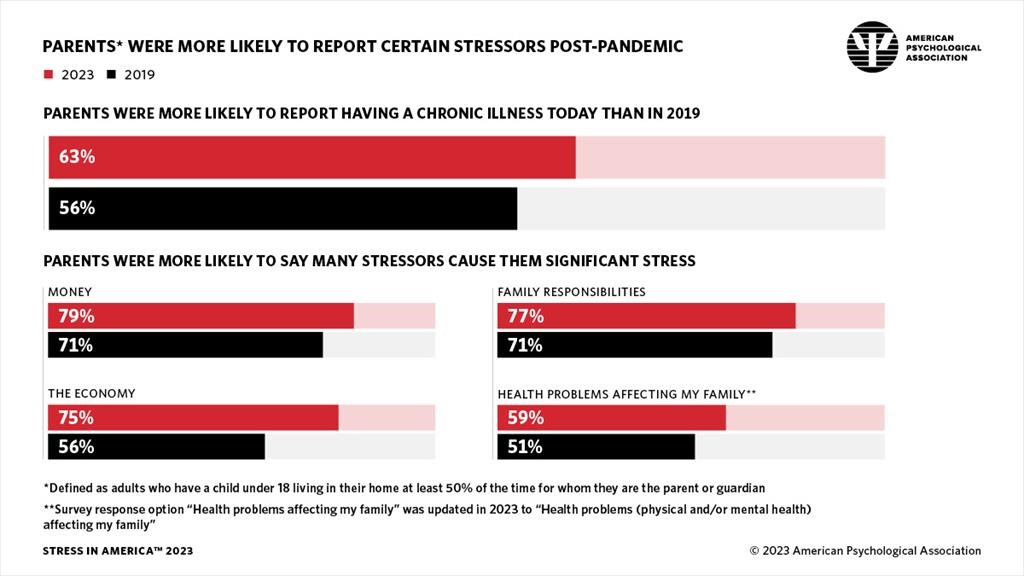
In addition to stress related to money and the economy, most parents also feel more stress post-pandemic dealing with family responsibilities and health problems affecting their family — both physical and mental health included in that assessment.
Furthermore, most parents were also more likely to report having a chronic condition in 2023 than in 2019, pre-pandemic — increased to 63% from 56% of parents.
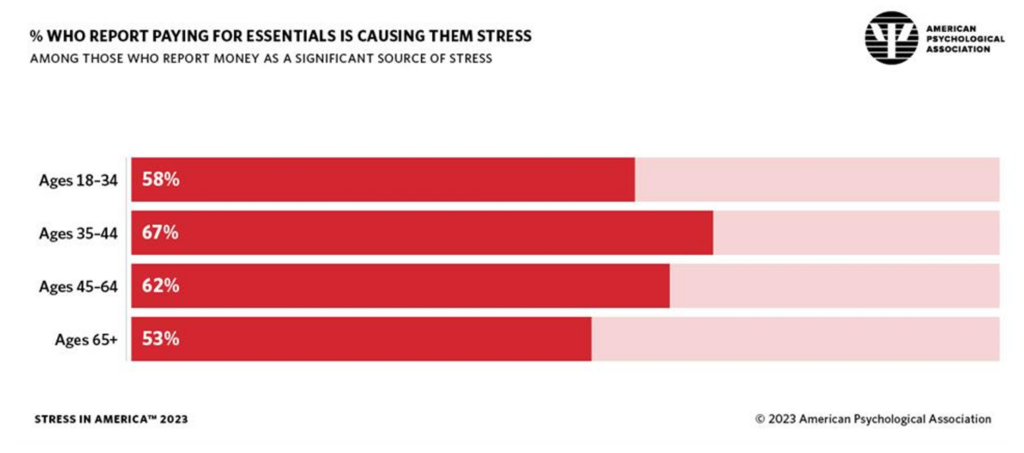
This third chart illustrates the consistent role that finances play into Americans’ lives in 2023 — as a significant source of stress across all generations and ages, and for most people across these age cohorts.
Most people in America are stressed when paying for essentials — thinking housing, utilities, gas for the tank, and education expenses among key money-stress triggers.
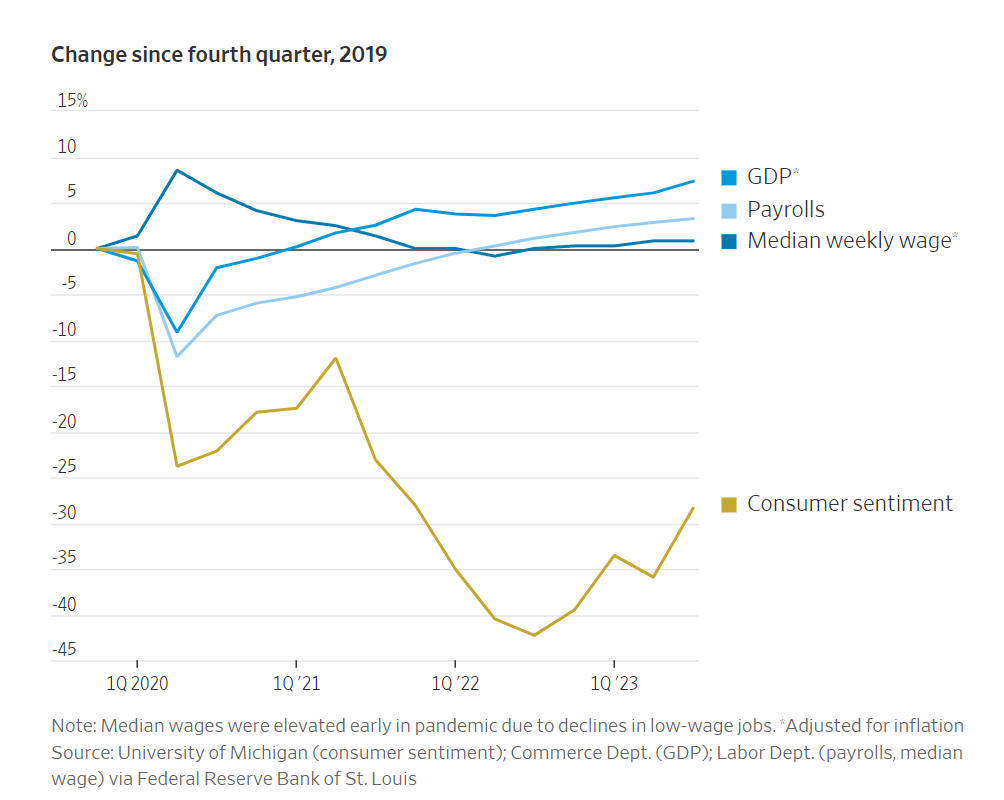
Health Populi’s Hot Points: Earlier this week on November 1, The Wall Street Journal published a story titled, “The Economy is Great. Why Are Americans in Such a Rotten Mood?”
This line graph contrasts the relatively “great” economy that WSJ’s Greg Ip discusses in his column — an upticking GDP and payrolls vis-a-vis consumer sentiment underwater.
That’s the psychology and mental health stress due to finances, even when the larger economy is faring pretty well versus the rest of the world.
Ip writes, “I suspect a lot of pessimism about the economy is ‘referred pain.’ Just as one part of your body can hurt because of injury to another, pessimism about the economy may reflect dissatisfaction with the country as a whole. Lately, there has been a lot to be dissatisfied about: intensifying political and cultural conflict and intolerance, the pandemic, the border, mass shootings, crime, war in Ukraine and now the war in the Middle East.”
That’s a long list of issues translating into so-called “referred pain,” which is the stress the APA highlights in the 2023 survey which was conducted among 3,185 U.S. adults 18 and over in August 2023. (Note that was nearly three months before the Hamas-Israel conflict, the Maine mass shootings, and the U.S. House of Representatives long processes to electing a majority leader). 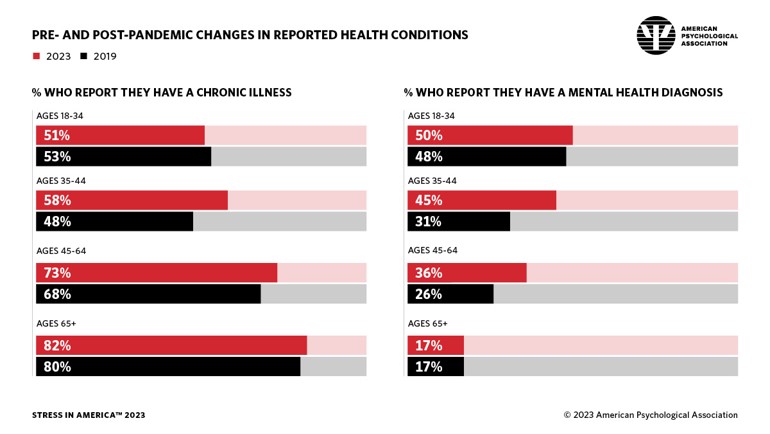
The APA reminds us at the end of the report how stress shapes our health based on a carefully considered evidence base of hundreds of peer-reviewed studies. They offer six key observations for us to keep in mind:
- Stress can manifest in the body
- Physical effects of stress can be damaging even when you appear “fine” on the outside
- Effects don’t end when the stressful experience ends
- Social support is good for everyone
- Some coping mechanisms don’t suffice in unbearable situations
- You need stress—and often grow from it.
The APA reminds us that stress is ubiquitous, but there are buffers and counter-vailing strategies that can help people mitigate the negative effects of stress.
Let me conclude with a focus on #3 and #4: that the negative effects of stress don’t end when the stressful experience stops, and that social support is good for everyone.
I leave you with a simple, hopeful mantra from one of the parents of medicine, Hippocrates; he wrote,
“Healing is a matter of time, but it is also a matter of opportunity.”
We are all Stressed in America now. We must take the opportunity to reach out to each other — across political and social chasms, across religious identities, across global boundaries — to kickstart that healing. This is the ultimate driver of health and well-being — the real connected health.
[I’ve covered this study for many years; if you are interested in past takes on Stress in America from the APA, you can use the “search” box at the top right of this blog site and type in ‘APA Stress in America’ to generate a list of past posts on this important research going back many years].


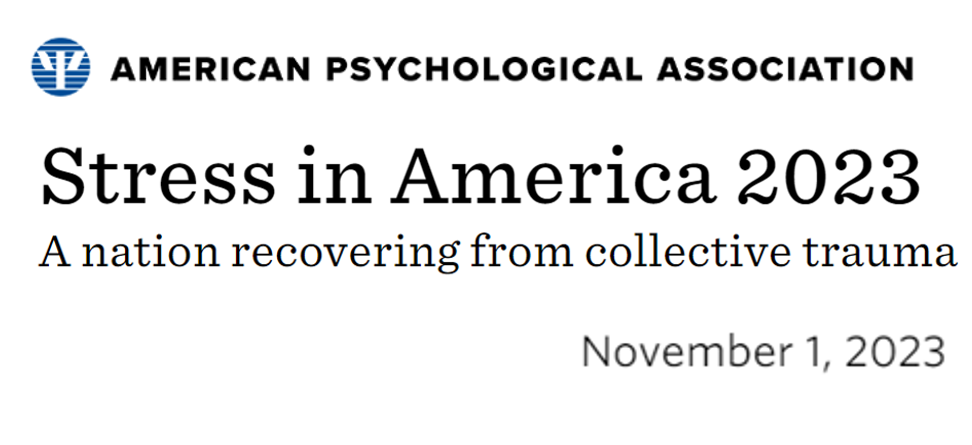


 Interviewed live on BNN Bloomberg (Canada) on the market for GLP-1 drugs for weight loss and their impact on both the health care system and consumer goods and services -- notably, food, nutrition, retail health, gyms, and other sectors.
Interviewed live on BNN Bloomberg (Canada) on the market for GLP-1 drugs for weight loss and their impact on both the health care system and consumer goods and services -- notably, food, nutrition, retail health, gyms, and other sectors. Thank you, Feedspot, for
Thank you, Feedspot, for  As you may know, I have been splitting work- and living-time between the U.S. and the E.U., most recently living in and working from Brussels. In the month of September 2024, I'll be splitting time between London and other parts of the U.K., and Italy where I'll be working with clients on consumer health, self-care and home care focused on food-as-medicine, digital health, business and scenario planning for the future...
As you may know, I have been splitting work- and living-time between the U.S. and the E.U., most recently living in and working from Brussels. In the month of September 2024, I'll be splitting time between London and other parts of the U.K., and Italy where I'll be working with clients on consumer health, self-care and home care focused on food-as-medicine, digital health, business and scenario planning for the future...